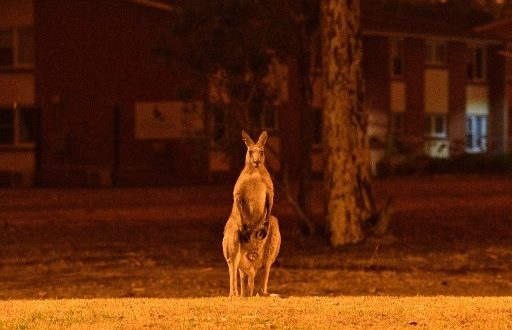Australian wildfires animals dead, fires kill half a billion animals.
Australia’s animal population is unquestionably special. Many of its best-known species, including kangaroos and koalas, are native to the country, and many animals found there aren’t found in any other nations outside zoos.
In the massive bushfires sweeping the country, Australia’s wildlife is helpless and populations are being devastated. Some of the most heartbreaking images and videos coming out of the crisis involve Australia’s animals — koalas shielding their babies from smoke, kangaroos being comforted, Patsy the Wonder Dog saving a herd of sheep, piles of burn cream and bandages stacked up, ready to treat injured wildlife.
Shockingly, no clear end is in sight. The bushfires, experts say, could last for months. As we point out in our primer on the fires, hot and dry conditions last through April in Australia, which won’t help the situation. But you can. Numerous charities are working around the clock to try and save Australia’s beloved animals. We’ll continue to update this post as conditions change and news breaks.
How many animals are involved?
This question is never going to have a definitive answer, but even the estimates are staggering. Unlike humans, animals don’t have birth certificates or other ways to track them accurately. But on Jan. 8, University of Sydney ecologist Chris Dickman offered a horrifying new estimate of the number of animals killed in the bushfires.
Dickman estimates more than a billion animals have been killed across Australia, with 800 million dead in the worst-hit state of New South Wales alone. Early estimates included only mammals, birds and reptiles, but Dickman notes that once the insect, bat and frog populations are added in, a billion begins to look like a low estimate.
The World Wide Fund for Nature, or WWF (known in the US and Canada as the World Wildlife Fund), used Dickman’s numbers to create its own sobering estimate that 1.25 billion animals may have been killed directly or indirectly by the fires.
A recent report in The New York Times notes that some experts are “dubious” about the numbers. There’s naturally limited access to the burned areas, and the death toll is arrived not by counting individual animals, but through math — multiplying the number of animals expected to inhabit a given area by the total acreage burned.
Which animals are affected?
So many different species, from livestock to insects, have been touched by the fires. There’s no way to make a chart of which populations were hit the hardest, but statistics on some of the different animals are beginning to emerge.
Koalas
The images of injured koalas, long a favorite animal of many and an Australian icon, have dominated worldwide media coverage. Terri Irwin, widow of famed naturalist Steve Irwin, told Australian morning program Sunrise the koala’s natural instincts and habitat work against them. “Koala instinct is to go up, as safety is in the top of the tree,” Irwin said. “Eucalyptus trees have so much oil that they ignite and actually explode in a fire.”
Again, numbers are hard to come by, but the news isn’t good. A NASA image of Kangaroo Island off of Australia’s southern coast shows a full third of the island is now covered with burn scars or active fires. Ecologists in Flinders Chase National Park there estimate 25,000 koalas — half the island’s population — may have been killed.
Flying foxes
Steve Irwin’s daughter Bindi Irwin recently posted about another species that’s been affected.
“Hundreds of grey-headed flying foxes, a species listed as vulnerable, have been flown to Queensland after the rescue center they were recovering in was at risk from fire and evacuated,” Irwin said. “Some of the orphans are now being cared for by the team at the zoo’s wildlife hospital until they’re big enough to go home, and there’s no threat of fire.”
She notes that the flying foxes are affected by other issues as well, and back in September, flying fox admissions to the zoo’s hospital “skyrocketed by over 750% due to drought conditions and lack of food.”
 Canada Journal – News of the World Articles and videos to bring you the biggest Canadian news stories from across the country every day
Canada Journal – News of the World Articles and videos to bring you the biggest Canadian news stories from across the country every day



